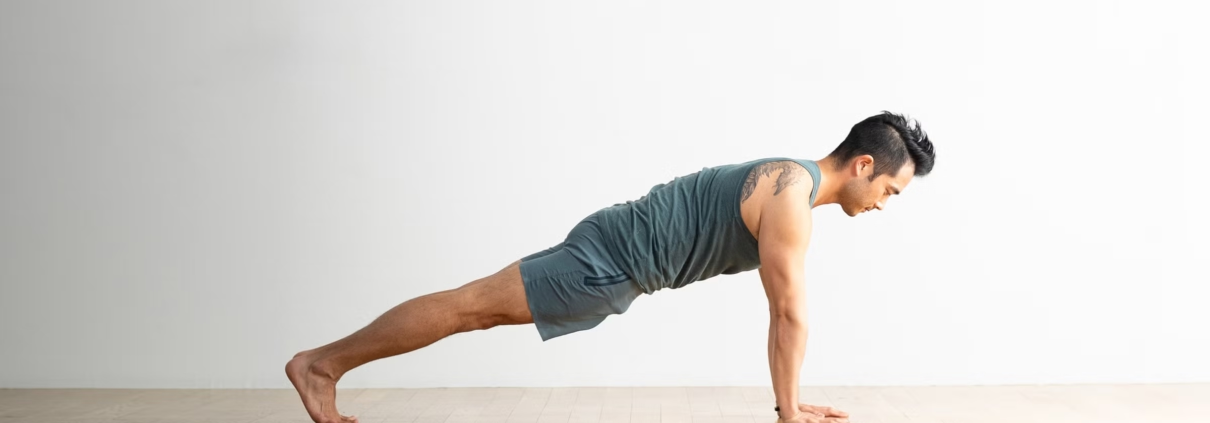Plank Pose Yoga: Strengthen Your Core and Mind
Plank Pose, known as Phalakasana in Sanskrit, is one of the most foundational poses in yoga. Despite its simplicity, it delivers a powerful workout for the entire body. Plank Pose Yoga is more than just a core-strengthening exercise—it’s a full-body practice that builds endurance, stability, and mental focus.
Whether you’re a beginner or an advanced yogi, practicing Plank Pose regularly can significantly improve your posture, increase your strength, and enhance your overall yoga performance. In this blog, we’ll explore everything you need to know about Plank Pose Yoga, including how to do it correctly, its benefits, variations, and common mistakes to avoid.
What is Plank Pose in Yoga?
Plank Pose, or Phalakasana, is a basic yoga posture that involves holding your body in a straight line, supported by your hands and toes. It looks similar to the “top of a push-up” position and is often used in yoga flows, such as Vinyasa or Sun Salutations.
The pose primarily targets the core, but it also engages the shoulders, arms, legs, and glutes. While it may look easy, maintaining proper alignment and holding the pose for extended periods can be challenging and incredibly rewarding.
How to Do Plank Pose Correctly
Follow these steps to safely and effectively perform Plank Pose:
- Start in a tabletop position with your shoulders stacked above your wrists and knees under your hips.
- Step your feet back one at a time until your legs are straight and your body forms a straight line from head to heels.
- Engage your core by pulling your belly button toward your spine.
- Press into your palms, spreading your fingers wide and keeping your shoulders away from your ears.
- Keep your neck in line with your spine by gazing down and slightly forward.
- Hold the pose for 20 to 60 seconds, or as long as you can maintain good form.
Tips for Alignment:
- Keep your hips level and avoid sagging or raising them too high.
- Distribute your weight evenly between your hands and toes.
- Keep your heels pressing back and thighs engaged.
Benefits of Plank Pose Yoga
Plank Pose offers a wide range of physical and mental benefits. Here are some of the key advantages:
1. Strengthens Core Muscles
Plank Pose is excellent for building a strong core, which is essential for stability, balance, and injury prevention.
2. Tones the Upper Body
Your shoulders, chest, and arms are all actively engaged, making this pose a great upper-body strength builder.
3. Improves Posture
By strengthening your back, core, and shoulders, Plank Pose helps align your spine and improve overall posture.
4. Enhances Endurance
Holding the pose for longer periods helps develop muscular endurance and mental focus.
5. Boosts Mental Focus
The need for concentration and breath awareness in Plank Pose makes it a mindful practice that can help reduce stress and improve focus.
Variations of Plank Pose
If you want to modify or intensify your practice, try these Plank Pose variations:
- Forearm Plank (Dolphin Plank): Rest on your forearms instead of your hands for a deeper core workout.
- Side Plank (Vasisthasana): Rotate to one side and balance on one arm for lateral strength.
- Knee Plank: A beginner-friendly option where you keep your knees on the ground to reduce pressure on the wrists and shoulders.
- Plank with Leg Lift: Add a challenge by lifting one leg at a time while maintaining alignment.
Common Mistakes to Avoid
- Sagging Hips: This puts unnecessary strain on your lower back.
- Butt Too High: Lifting your hips breaks the alignment and reduces core engagement.
- Locked Elbows: Keep a slight bend to avoid joint strain.
- Holding Your Breath: Remember to breathe deeply and consistently throughout the pose.
Conclusion
Plank Pose Yoga may appear simple at first glance, but its benefits run deep. It’s a powerful pose that strengthens the core, tones the body, and enhances mental clarity. Whether you’re practicing yoga for fitness, flexibility, or mindfulness, incorporating Plank Pose into your routine can elevate your practice.
Consistency is key. With regular practice, you’ll not only build strength but also improve your body awareness and posture. Remember to listen to your body and modify as needed. Even holding the pose for just 30 seconds a day can yield noticeable results over time.
Frequently Asked Questions (FAQs)
Q1: Is Plank Pose suitable for beginners?
Yes, Plank Pose is beginner-friendly. Modifications like Knee Plank can make it more accessible while still building strength.
Q2: How long should I hold Plank Pose?
Start with 20 to 30 seconds and gradually work up to 1 minute or longer as your strength improves.
Q3: Can Plank Pose help with weight loss?
While it’s not a high-calorie-burning exercise on its own, Plank Pose builds muscle and supports metabolism, making it a valuable part of a weight-loss routine.
Q4: What should I do if I feel wrist pain?
Try practicing on your forearms or use yoga blocks to reduce wrist strain. Make sure your hands are aligned properly and your weight is evenly distributed.
Q5: How often should I practice Plank Pose Yoga?
Daily practice, even for a minute or two, can produce significant benefits over time.




Leave a Reply
Want to join the discussion?Feel free to contribute!